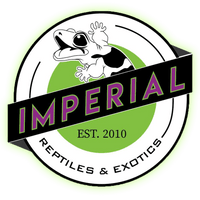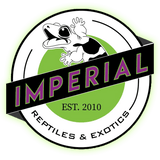
Leachie Diet, Size, and Enclosure Requirements
Leachianus Geckos are masters of camoflauge, even at their size. The preferred habitat is in the canopy of the forests. Leachies do not come to the forest floor often. Their Size Range from roughly 9-17 inches depending on the locale (see below). To help them stay camouflage, leachies have a mottled mossy pattern that makes them almost disappear into the background. Their color can vary depending on locale and some can have green, white, orange, pink, and purple patterns. As Leachies have become more popular and available as pets, the coloring that they come in and the vibrance of the color has been refined. These giant geckos have large heads, sticky toe pads with small claws, and loose velvety skin. Their tail is much smaller than some of the other New Caledonia geckos - like crested geckos and gargoyle geckos.
Like it’s other New Caledonia cousins, Leachies are not hard to care for once a proper set up has been achieved. These geckos can live up to 20 years with proper care. These are big geckos and they need an enclosure large enough for them to move around and exhibit the behaviors they would in the wild. Since these geckos are arboreal, the enclosure needs to have some height to it. The minimum a Leachie should be housed in is a 24” x 18” x 24” (exoterra Medium Tall). Foliage like plants and cork rounds can go a long way to help your pet Leachie gecko feel secure. As babies and juveniles, be sure to house them in an enclosure that is not too large for them, they can have a hard time finding their food and become stressed in too large of spaces. For babies a simple set up is perfect. Leachies can commonly be found plastered against the glass door of their enclosure or on a horizontal perch. Leachies can be confident and may not have a problem being out and being seen.
Ecoearth, coconut coir, or a bioactive soil mix is good for substrate as they enjoy a nice humid environment. Their humidity should range from 60-80% and daily misting can go a long way to assist the humidity and to make sure your animal is staying hydrated. Temperatures of 75-78 degrees Fahrenheit is ideal for day time temperatures and you may offer a low-heat basking spot. At night the temperatures can drop into the low 70s. Monitoring the temperature and humidity with a digital read thermometer/hydrometer can ensure appropriate temperatures are being maintained.
Leachies are nocturnal meaning they are primarily active at night. About 12 hours a day of light is appropriate for the gecko, but UVB is not exactly a requirement since they would only be exposed to minimal UVB during the day. If the leachie is in a planted enclosure that needs UVB to grow, make sure the UVB is a lower percent. If UVB is not being offered, the gecko will benefit from some calcium with D3 sprinkled on their feeder insects.
The main diet that is fed to Leachies in captivities, like other New Caledonia geckos, is a powder that is mixed with water to form a paste the geckos eat. This mix has all the nutritional requirements that a Leachie needs. Brands like Repashy, Pangea, and Lugarti make different variations of this diets that include different foods and insects. Babies through their first year of life should have daily access to this mix and be given insects 2 to 3 times a week. Over a year old, the mixed diet can be given every other day or every three days and insects can be given 1-2 times a week. Dusting with supplements like calcium with D3 help keep your gecko happy and healthy.

Breeding
Leachies reach adult size at around 3 years old. Offshore-island geckos should roughly be 120 grams and mainland geckos will be closer to 180 grams. Mature males will have two hemipenal bulges and femoral pores that can be seen with a sexing loupe. Keeping temperatures in the low 70's (degrees Fahrenheit) throughout November to February may help stimulate breeding behavior. Make sure the animals have a full stomach before introducing them.
When housing a breeding pair of leachianus geckos, a larger enclosure is needed. Leachies can be territorial and they need to have enough space to get away from each other if needed. Leachie breeding can be vary rough. In some cases, it's similar to human relationships. Sometimes pairs can bond for life, other times they get a divorce, and of course sometimes they just aren't meant for each other at all. The ones that don't get along can cause serious damage to one another. It's important to keep a vigilant eye when pairing them for the first time. Once a pair has been established, it's best to leave them as a pair. Moving the male to different enclosures with different females can also result in fights. Incompatible animals may bark.
Females will lay eggs around 30 days of copulation, so keep a nest box in the enclosure. Mature females can lay 1-6 clutches of 2-3 eggs each. The eggs can be incubated at room temperature of even temperatures similar to the adult enclosure. It may take 45-150 days (temperature dependent) for your eggs to hatch. Eggs incubated at warmer temperatures typically produce a higher percentage of males and also hatch much more quickly.

Locales
The locale of your leachie can dictate the look and size of the animal. Nuu Ana (smaller in size with a green/yellow base and white or pink crisp blotches with black speckling) and Nuu Ami (greenish brown color with patterning ranging from very small white blotches to very large white blotches sometimes called "snowflaking". Their patterning sometimes also exhibits pinks or peach colours. This is also a larger Island locale, similar in size to Pine Isle and Moro) are fairly common locales. Pine Isle and Moro Leachies get roughly 12- 13 inches in length. Brosse, Bayoonaise, and Caanawa are not as common.
And of course, the reason we all love Leachies is the SIZE. Grande Terre or GT Leachie Geckos are the largest variety (14-17+") of these New Caledonia Geckos. The GT forms can also vary in color and pattern. Poindimié have dark olive green to dark chocolate colorations. Yate range from brown to golden yellow. Mt. Humboldt are usually olive green with brown markings. Then there are "Type C" GT which are a variety that originated from Phil Tremper's breeding collection and they are said to be that largest recorded Leachies.
Links:


























